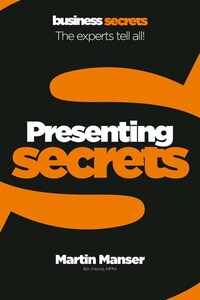We give presentations to provide information, explain something, present choices, sell a product or service, or persuade others to follow a course of action. Unfortunately, presentations can be dull. But yours doesnât have to be. Iâve written this book to guide you through every step of the preparation so that your presentation communicates your message effectively and is successful.
My natural temperament is to be shy. Being the youngest of four children meant that I was a listener and generally kept my thoughts to myself. Gradually over the years Iâve come out of my shell and had the courage to express myself. Actually, itâs been a long and at times difficult struggle â and at times Iâve wanted to say something in a larger group but havenât been brave enough to do so.
Iâve been giving presentations on various subjects for many years now and have gradually become less nervous and more confident. So I want to share with you some of the tips, hints and techniques that Iâve learnt the hard way.
This book consists of 50 secrets of giving good presentations, divided into seven chapters:
⢠Prepare the basics. If you have a clear idea of your audience and what you want to tell them, you are already on the way to success.
⢠Work on your words. You need to spend time refining your key messages to make sure they are clear.
⢠Plan for props and other people. Good use of visual aids can make a huge impact. A picture really can speak a thousand words.
⢠Prepare your mind. Positive thinking makes a positive difference. Itâs normal to be nervous; you donât need to be afraid of fear.
⢠Interact with your audience. Remember youâre giving a presentation, not a speech. An effective dialogue with the audience will ensure that you are giving them what they want.
⢠Be aware of body language. Research has shown that body language is an important factor in a successful presentation.
⢠Learn from feedback. Whether you are an experienced presenter or a first-timer, there is always more to learn.
If you follow these 50 secrets, you will know everything you need to deliver a brilliant presentation. Your audience will remember your message and, just as importantly, they will remember you.
Whether you are an experienced presenter or a first-timer, you can make a positive impact on your audience and, just as importantly, enjoy doing so!
First of all, take a step back from thinking about the content of your presentation and think about your own personality instead. Remember that your audience will be listening to and looking at a presenter as much as a presentation.
You donât want simply to deliver a series of data and facts. You want to put your soul into this presentation, and enjoy yourself in the process. The most interesting, memorable and effective presentations have the personality of their presenter stamped all over them. You want to put across your values and opinions, and your audience wants to hear them. Here are some tips to help you from the start to develop a really positive, creative view of yourself as an interesting presenter:














